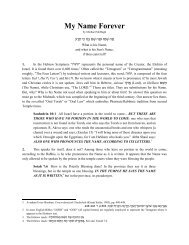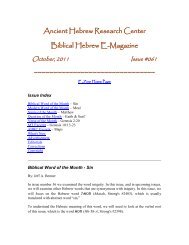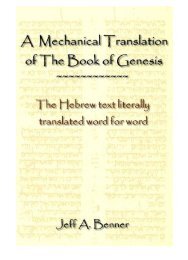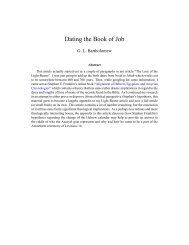Ancient Hebrew Language and Alphabet
Ancient Hebrew Language and Alphabet
Ancient Hebrew Language and Alphabet
Create successful ePaper yourself
Turn your PDF publications into a flip-book with our unique Google optimized e-Paper software.
<strong>Ancient</strong> <strong>Hebrew</strong> <strong>Language</strong> <strong>and</strong> <strong>Alphabet</strong><br />
By placing the consonant letter (nun) within the Parent<br />
Root, a new type of Child Root is formed. This Child<br />
Root is very closely related to the parent. For example,<br />
the Parent Root / @a / aph means nose or the<br />
flaring of the nostrils as when angry. The Child Root<br />
/ @na / anaph also means angry.<br />
Adopted Roots<br />
There are two forms of adopted roots that were probably<br />
derived at a later time through the evolution of the<br />
language 35 or adopted from another Shemitic language.<br />
The first is formed by adding a third consonant to a Parent<br />
Root forming a new root more specific in meaning than<br />
the parent, such as the examples below;<br />
p.r - Parent Root meaning break<br />
p.r.c - break forth<br />
p.r.k - break apart<br />
p.r.s - break in pieces<br />
p.r.q - break off<br />
p.r.ts - break open<br />
The second type of adopted root appears to be a three<br />
consonant root that evolved from the Parent Root into a<br />
new word with a similar sound. As a language evolves,<br />
35 Approximately 80% of all the words found in the Bible are derived<br />
from the parent or child root words, while the remaining 20% are<br />
derived from the combination roots. These significantly smaller<br />
numbers of combination roots indicate that these roots have a<br />
relatively late origin <strong>and</strong> are not part of the original <strong>Hebrew</strong><br />
vocabulary.<br />
37






